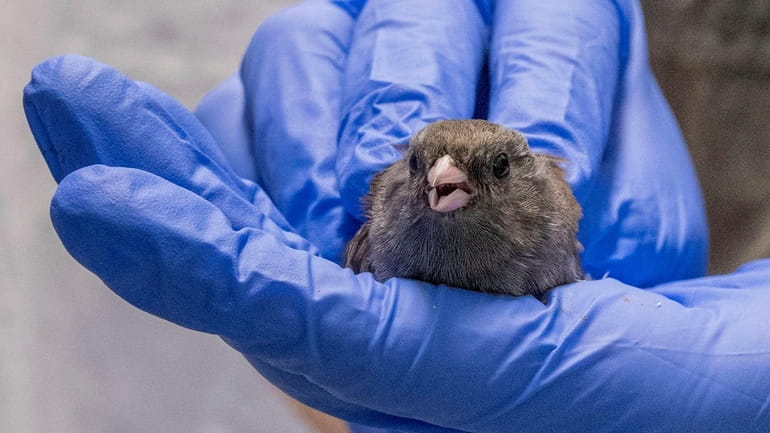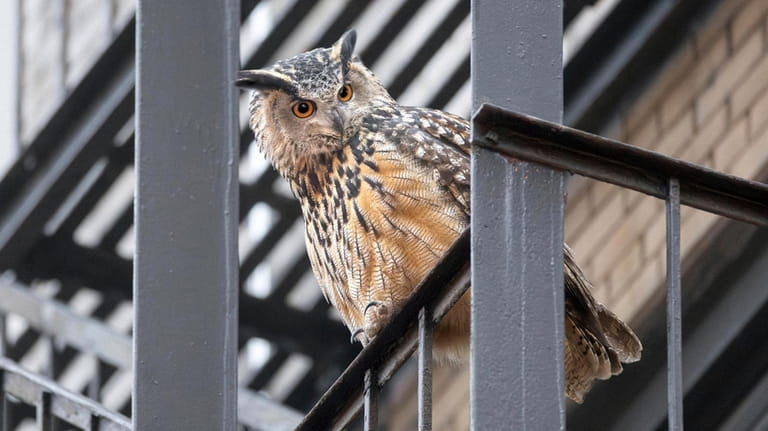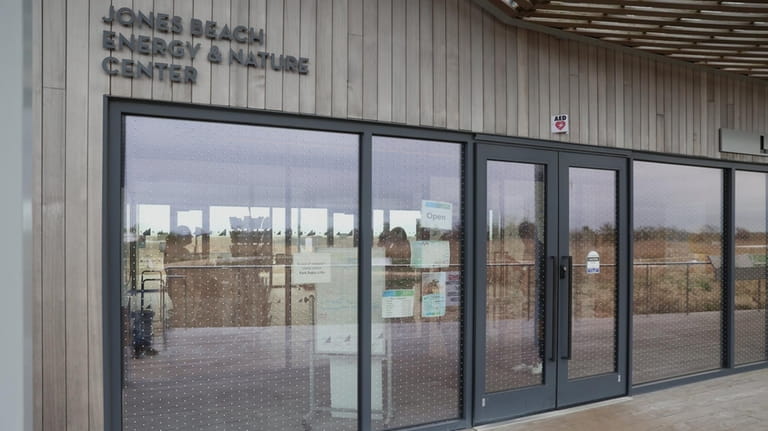Long Islanders consider ways to mitigate fatal crashes of birds into buildings

Janine Bendicksen, director of wildlife rehabilitation at Sweetbriar Nature Center in Smithtown, holds an injured junco. The center took in more than 100 collision victims in 2023. Credit: Rick Kopstein
A tiny dark-eyed junco was flitting about a cage at the Sweetbriar Nature Center in Smithtown, apparently restless to fly free. The bird had been recuperating for the past several days after it was found lying on the ground just outside a house in Kings Point.
When it arrived at Sweetbriar, the bird looked dazed and was still not moving, a sign of head trauma. “I knew right away he had hit a window,” said Janine Bendicksen, the center's director of wildlife rehabilitation.
Every spring, about 9 million birds travel across Long Island as they migrate along the Atlantic flyway from their wintering grounds in South America and the Caribbean to breeding grounds as far north as Greenland. Between mid-August and mid-October they make the trip in reverse, in even greater numbers.
“Something on the order of 40 million birds fly over Long Island in the fall,” Farnsworth said. On a peak night, 5 million to 6 million birds may be flying overhead.
WHAT TO KNOW
- Every spring, about 9 million birds travel across Long Island as they migrate along the Atlantic flyway from their wintering grounds in South America and the Caribbean to breeding grounds as far north as Greenland.
- Local birders say Nassau County's glass-clad office buildings are particular hazards for birds, but many are injured and killed when they hit windows on suburban houses, too.
- A steady stream of birds that fly into windows are delivered to Sweetbriar Nature Center in Smithtown and other rehabilitators, and not only during migration seasons.
Many find a convenient stopover in the Island's open spaces and backyards, but there are also perils, from free-ranging cats to reflective windows.
Local birders say Nassau County's glass-clad office buildings are particular hazards for birds, but many are injured and killed when they hit windows on suburban houses, too. Residents across Long Island deliver a steady stream of window-strike patients to Sweetbriar and other rehabilitators, and not only during migration seasons.
"I get them all year long," said Bendicksen, who took in more than 100 collision victims in 2023.
Some Long Island towns and building owners are testing strategies to help birds steer clear of windows. But experts suggest that unless those efforts are scaled up, many species of songbirds could slip closer to extinction.
Why birds fly into windows
Between 365 million and 988 million birds in the United States die from window collisions each year, according to a study by the U.S. Fish and Wildlife Service and the Smithsonian Migratory Bird Center. Most are migrating songbirds — thrushes, flycatchers, warblers — but raptors and year-round residents such as cardinals are also among the casualties.

Flaco the owl, shown in January on a Manhattan fire escape, died the following month. Proposed legislation in Albany has been renamed after the bird. Credit: David Lei via AP
Flaco, the Eurasian eagle-owl who was liberated from his tiny enclosure at the Central Park Zoo more than a year ago, thrilled wildlife enthusiasts by proving he could live free in the wilderness of the Upper West Side. But his adventures ended abruptly in late February when he crashed into a building on 89th Street.
Since 1970, 2.9 billion adult breeding birds have disappeared from North American skies, according to a 2019 study, and window collisions are a significant contributor to that precipitous decline.
“There’s no question it’s one of the biggest direct human sources of mortality for birds,” said Andrew Farnsworth, a bird migration specialist at the Cornell Lab of Ornithology. “It may be the biggest.”
Most birds travel at night when they are safer from predators and cooler temperatures allow them to conserve energy. But their routes and migratory skills developed thousands of years before the night sky was polluted with artificial light, which interferes with their navigational strategies, including their ability to sense the earth’s magnetic fields. Veering off course, birds find themselves in cities and suburbs, where they perceive illuminated interiors of buildings at night and reflected skies and trees on glassy exteriors in the daytime as open space.
The vast majority of collisions occur at low-rise buildings and private houses; according to a 2014 study, only 1% of window strike deaths occur at high-rises.
Rehabbing injured birds
A full-on collision with a window is usually fatal, but for those that survive, licensed wildlife rehabilitators on Long Island can help them recover.
In the past, rehabbers advised anyone who finds a bird that has hit a window “to keep the bird safe for a few hours and if he flies away, it’s all good,” Bendicksen said. “But now we know that he could have injuries and won’t survive.”
Birds can die hours or days later from brain swelling or other injuries. A robin recently brought to Sweetbriar lost the tip of its beak in a collision and can't eat its usual diet of insects and worms until the beak grows back. The bird would have starved outdoors.
Many rehabbers suggest any bird that hits a window should be brought in right away for treatment. “I would rather be on the conservative side,” said Noelle Dunlop, development director and rehabilitator at the Evelyn Alexander Wildlife Rescue Center in Hampton Bays. "It's best to bring the bird in for evaluation."
A small bird can be carefully placed in a paper or zippered cloth bag, Dunlop advises; a larger one can go in a cardboard box. Once birds arrive, she said, they may be given medication to reduce inflammation around the brain and for pain control, along with oxygen.
Dunlop said about half the window-strike birds they treat recover.
At Sweetbriar, the success rate is roughly the same. The junco was one of the lucky ones: About a week after it arrived, the bird was sprung from its cage.
Preventing collisions
A decade ago, the Jacob Javits Convention Center in Manhattan was a death trap for birds, but when its reflective glass panels were replaced with glass spangled with small dots in 2014, fatalities declined by 90%.
Elsewhere, architects have incorporated bird-friendly features such as patterned glazing, screens and grilles in their plans.
Short of a major renovation, some institutions on Long Island have installed relatively inexpensive patterned films and UV-reflective decals — which most species of birds can see but humans cannot — to break up reflections and make glass visible to birds.
Several years ago, members of the Four Harbors Audubon Society in Kings Park collected 20 dead birds in just one day around a group of buildings on Stony Brook University's South Campus, according to Patrice Domeischel, a member of the group's board.
"You might have a whole flock arriving after a long night of migration — they're tired, they land at first light," Domeischel said. So, certain buildings may get clusters of casualties. After the group applied a grid of UV decals to the windows, collisions dropped dramatically, Domeischel added.

The dot pattern on windows at the Jones Beach Energy and Nature Center deters birds from crashing into them. Credit: James Carbone
Bird-safe glass, film and decals also have been installed at the Jones Beach Energy and Nature Center, the Unitarian Universalist Congregation in Manhasset and Brookhaven Town Hall in Farmingville.
Wildlife advocates are pressing for new regulations to make windows less treacherous for birds. The Bird Safe Buildings Act — introduced in the New York State Senate last year and now renamed the FLACO Act — would require bird-safe features in buildings owned or leased by the state.
“Collisions are the biggest threat to birds behind cats, so if we can reduce that we can have a really significant impact on bird loss,” said Erin McGrath, senior policy manager at the National Audubon Society.
Advocates also are supporting a statewide “dark sky” law requiring street and other outdoor lights to be shielded, motion-activated or turned off, which could help birds avoid danger. State Sen. Anthony Palumbo (R-New Suffolk) is a co-sponsor.
“We are hoping that Flaco’s death will bring some momentum to the issue,” McGrath said.
John Turner, a conservation policy advocate at the Seatuck Environmental Association, suggests a nationwide approach: He said window strikes should be treated as a violation of the Migratory Bird Treaty Act of 1918, which prohibits killing or harassing migratory birds without a permit from the U.S. Fish and Wildlife Service. That could make owners of buildings where birds die subject to fines.
Meanwhile, the death toll continues — “30 birds a second in the worst-case scenario,” Farnsworth said. Those casualties, added to losses from cats, habitat destruction and climate change, are imperiling hundreds of species, from hawks to hummingbirds, he said.
“We know what the problem is. We have solutions, and they’re increasingly not terribly costly,” Farnsworth said. “We ought to be adopting these things everywhere.”
Treating injured birds
Wildlife rehabilitators:
- Sweetbriar Nature Center, Smithtown, 631-979-6344
- Evelyn Alexander Wildlife Rescue Center, Hampton Bays, 631-728-9453
- Wildlife Center of Long Island, Huntington, 516-674-0982
- Save the Animals Rescue Foundation, Middle Island, 631-736-8207
- Wildlife in Need of Rescue and Rehabilitation, North Massapequa, 516-293-0587
